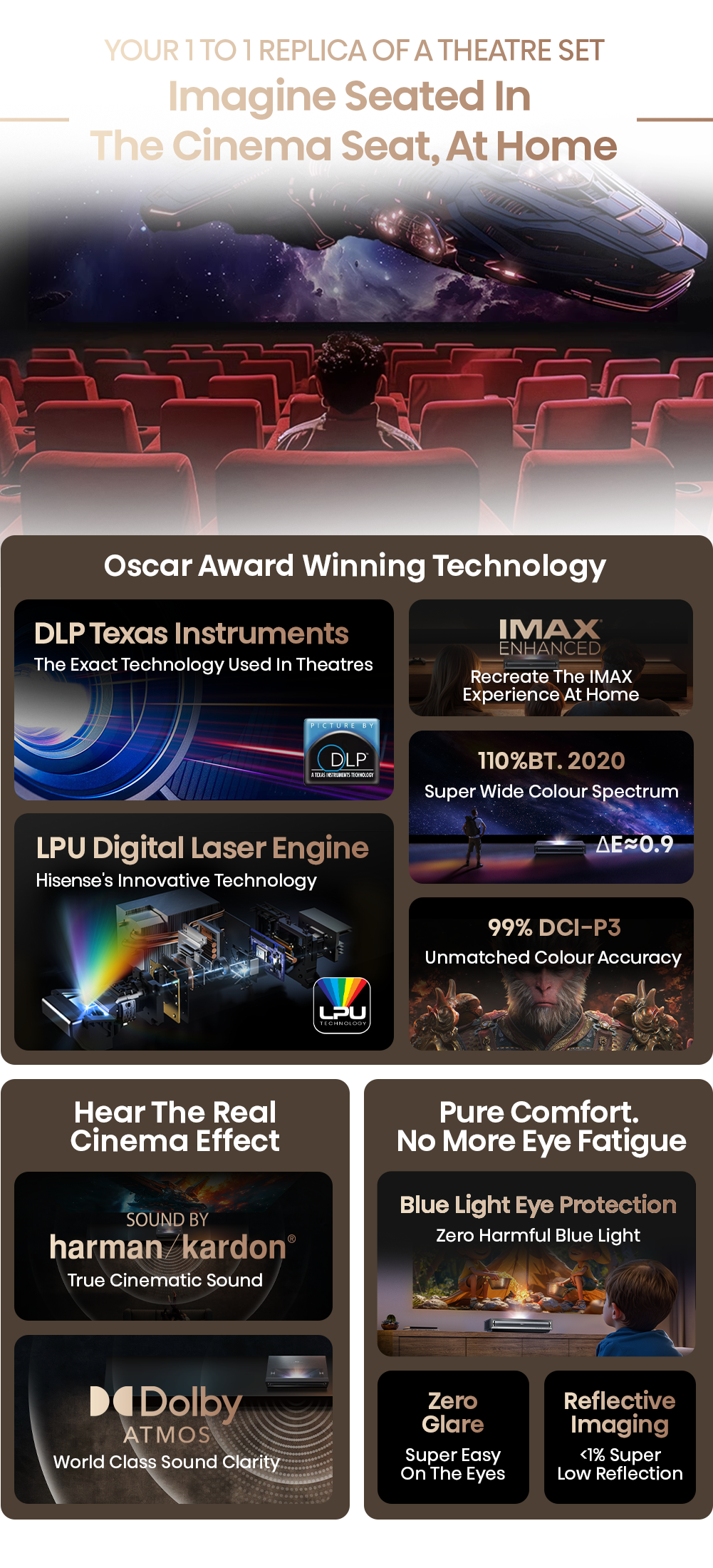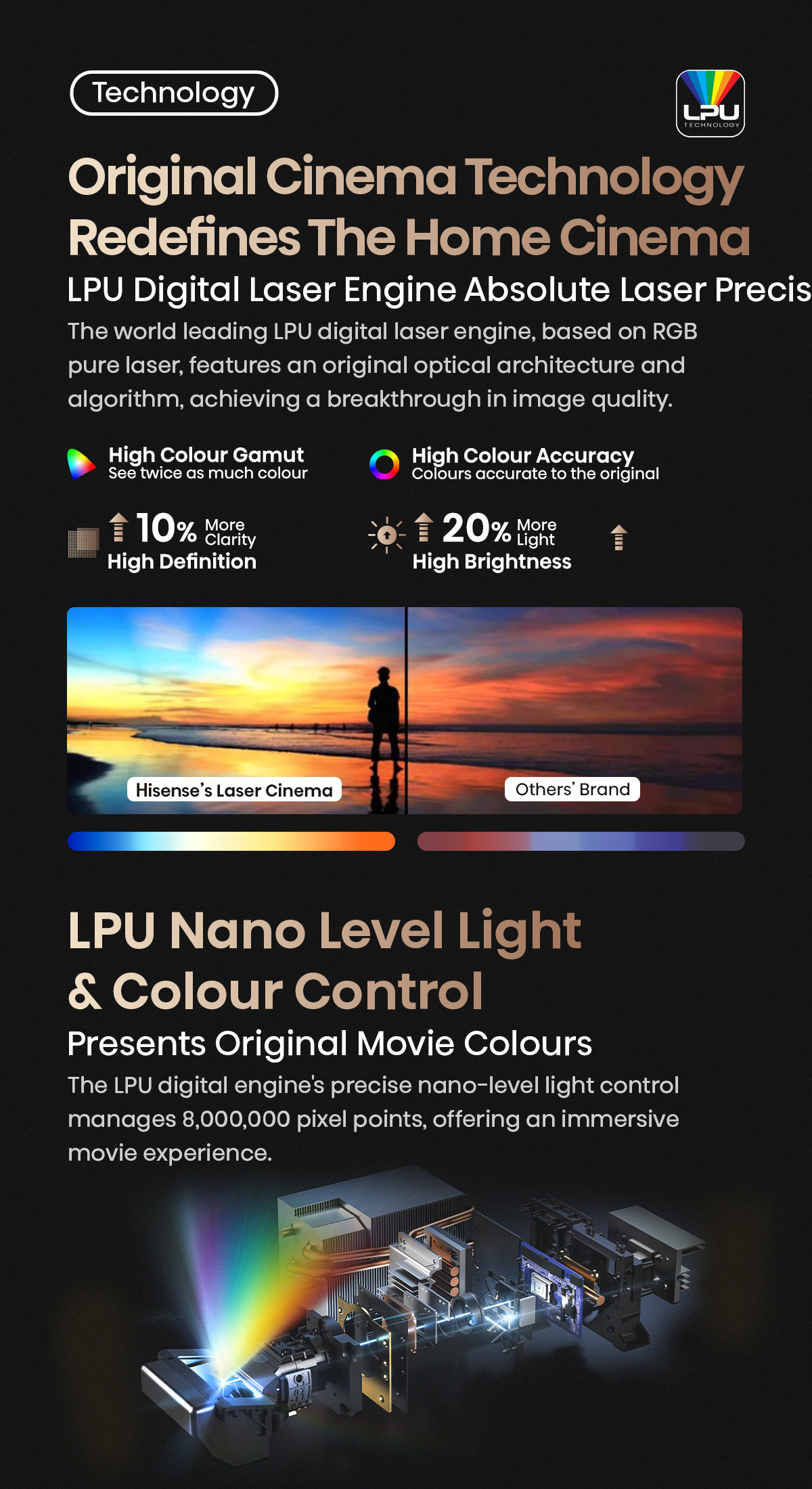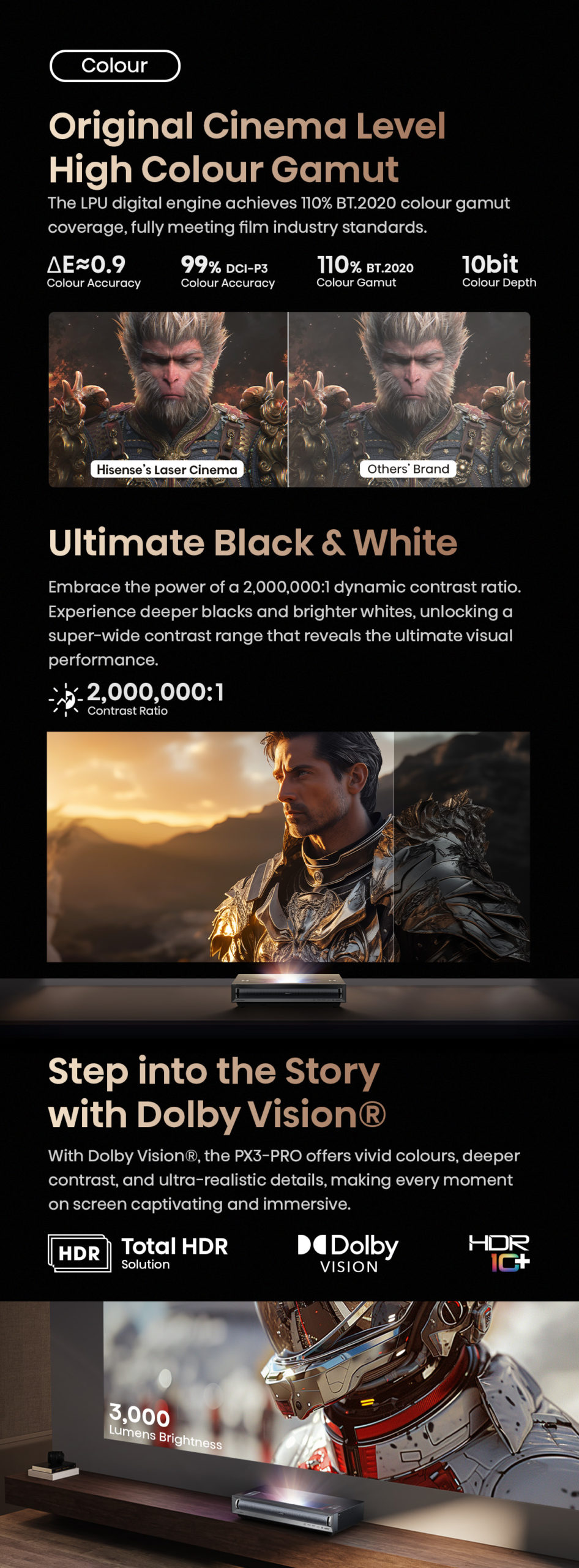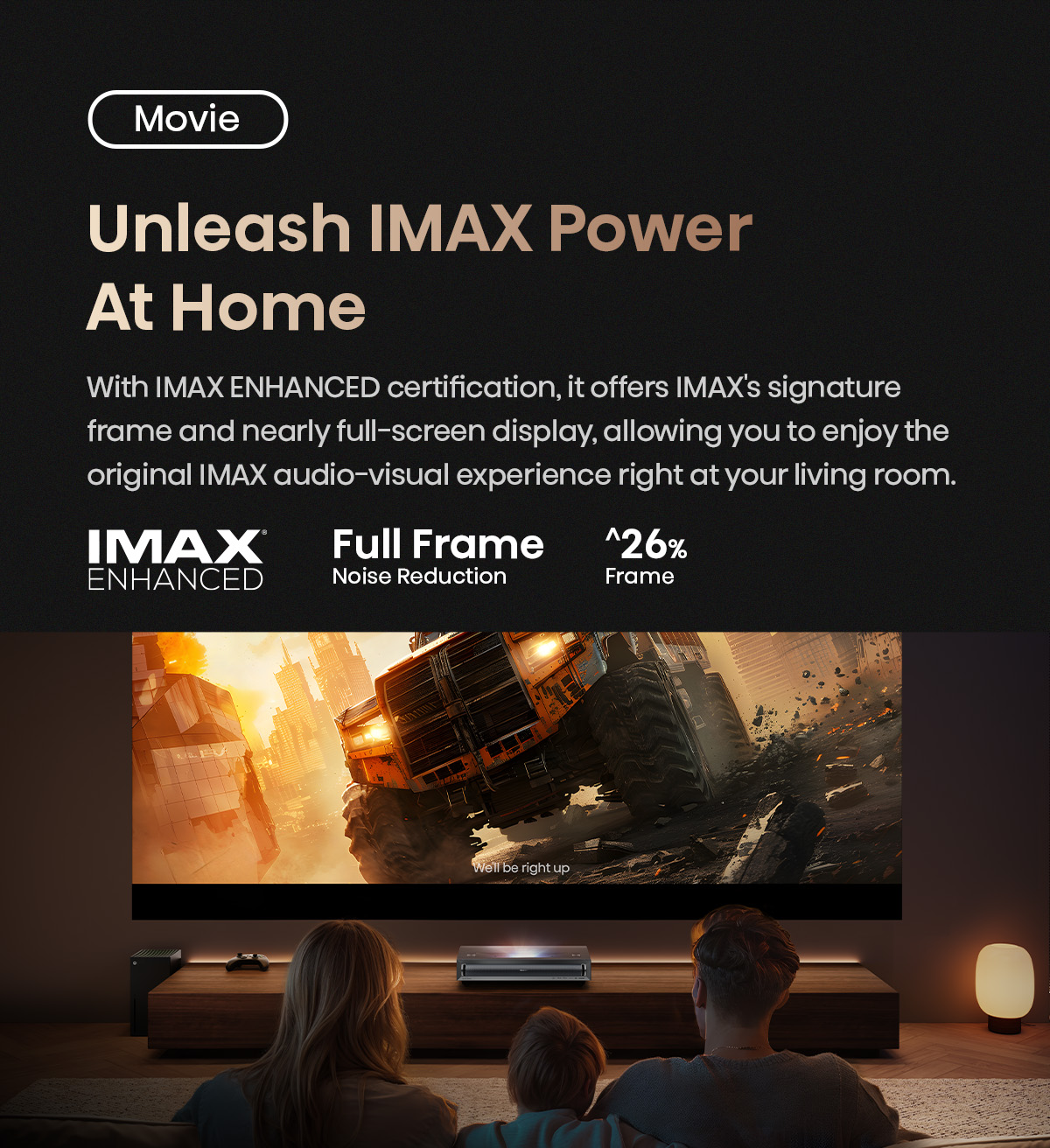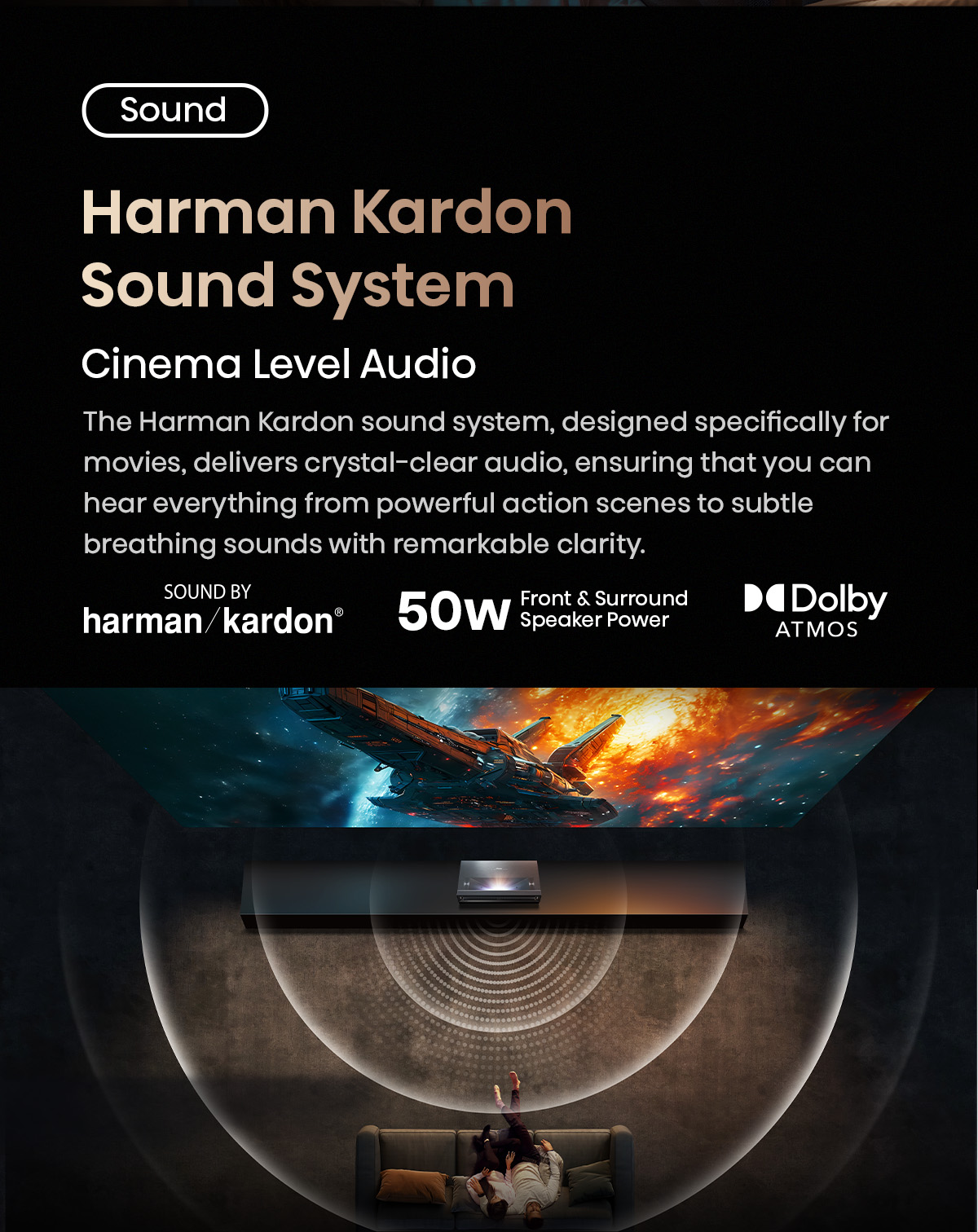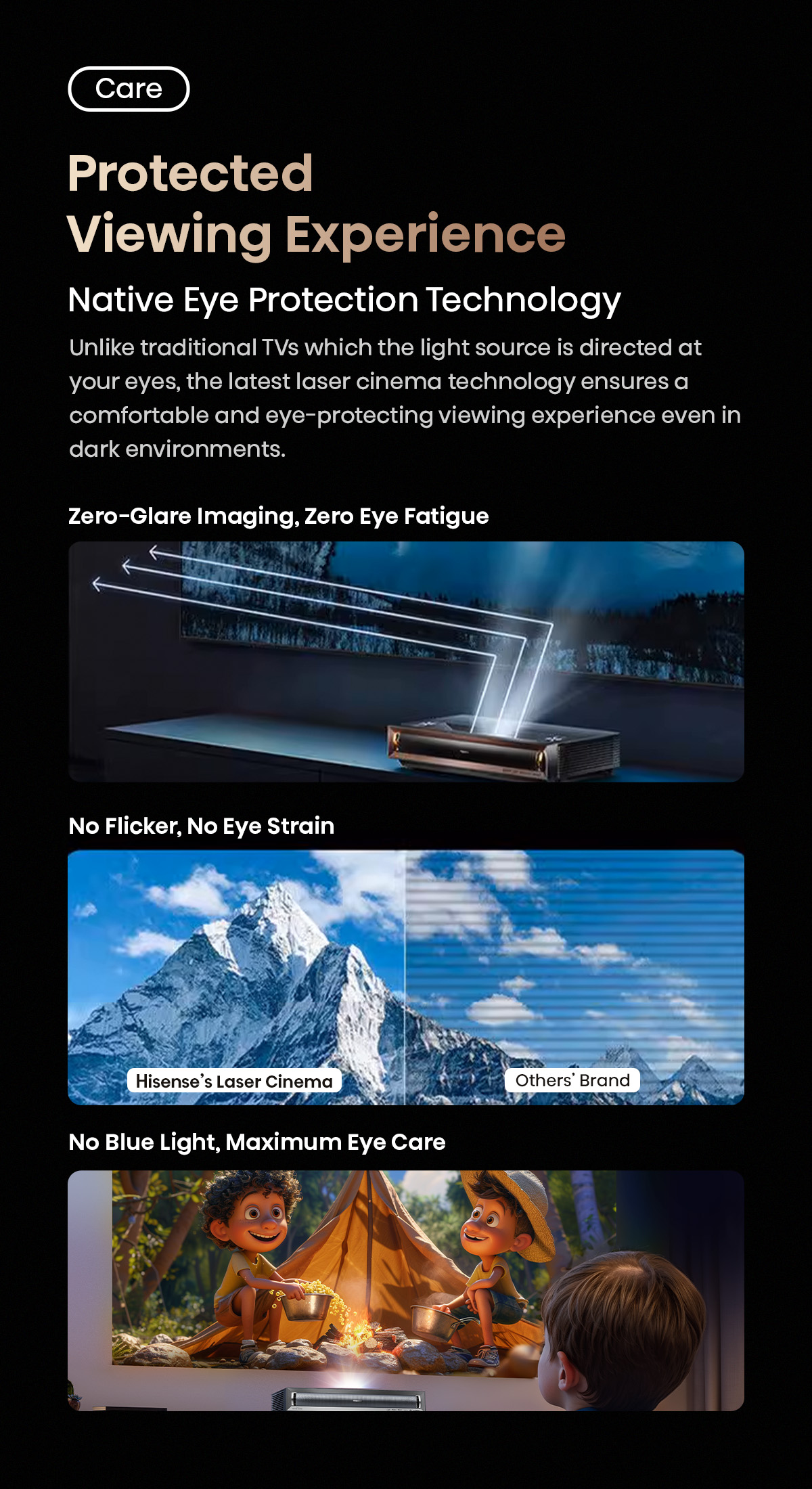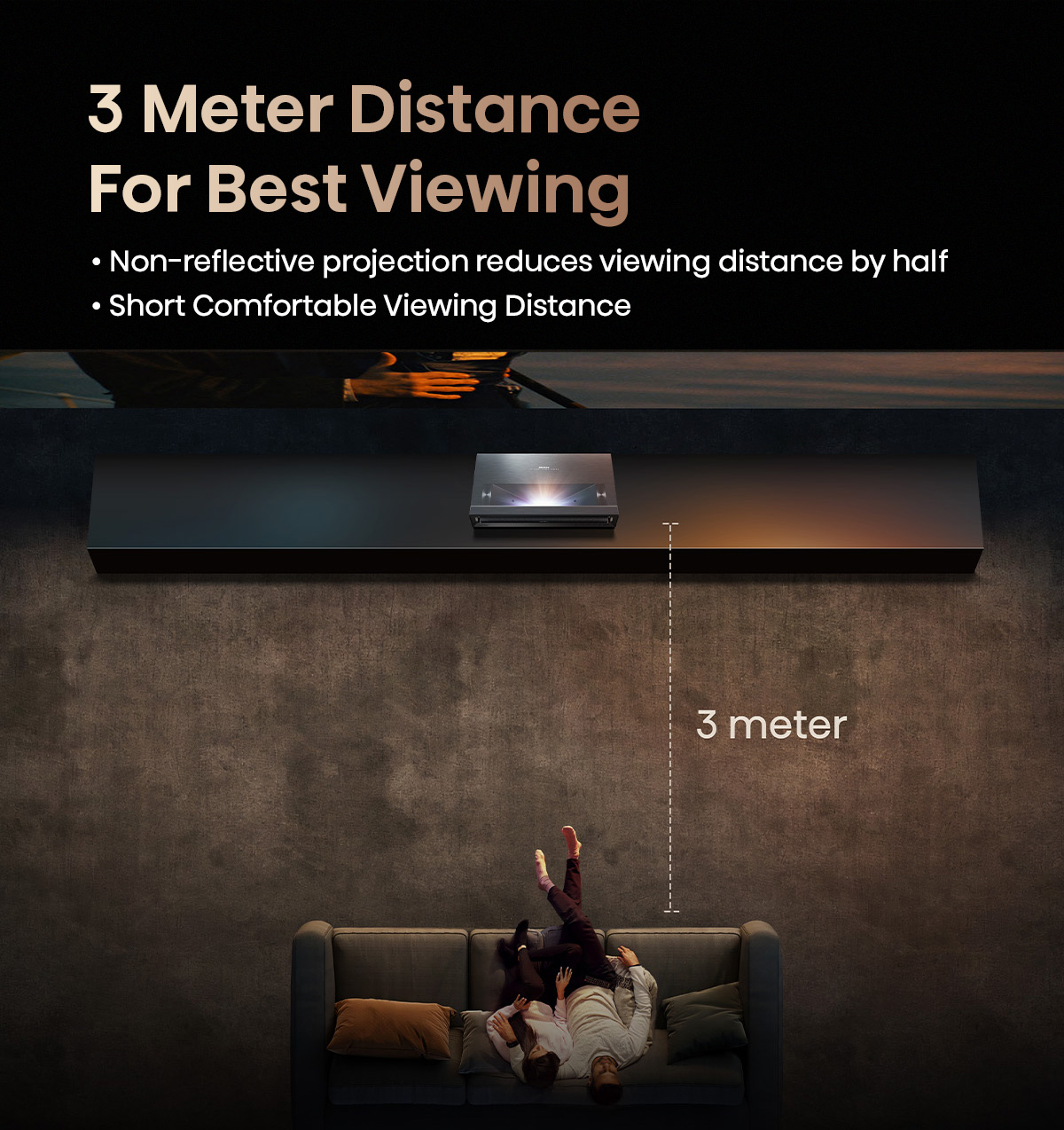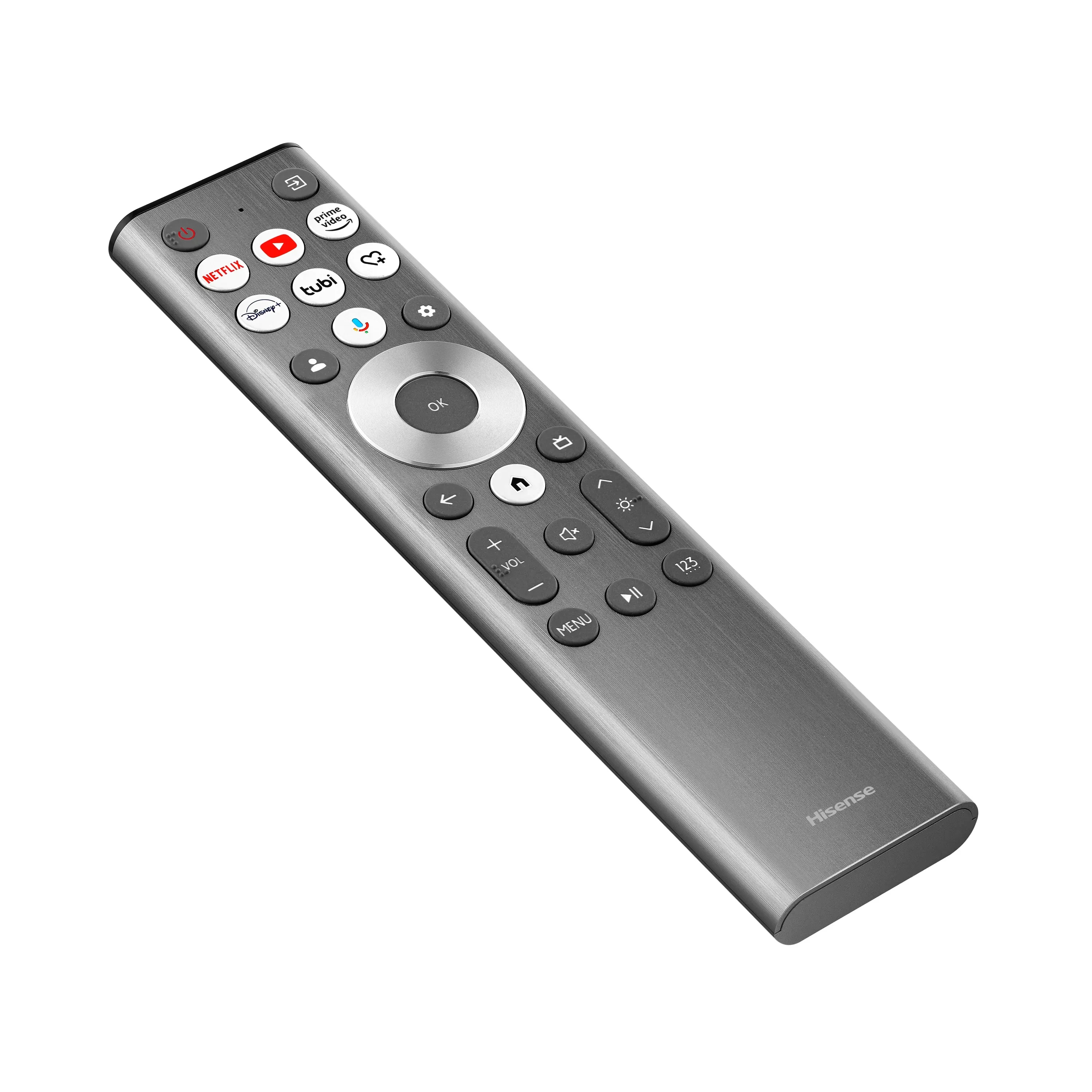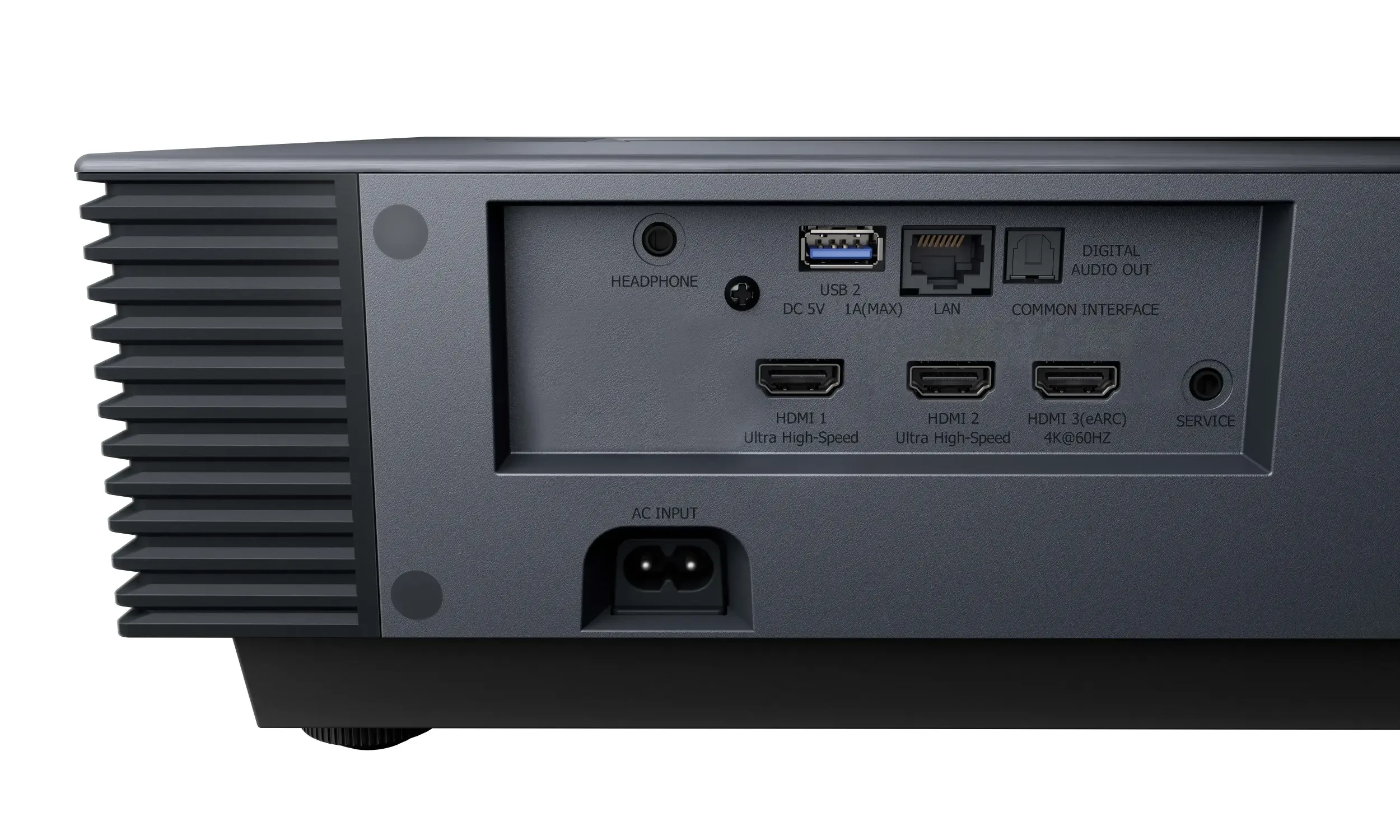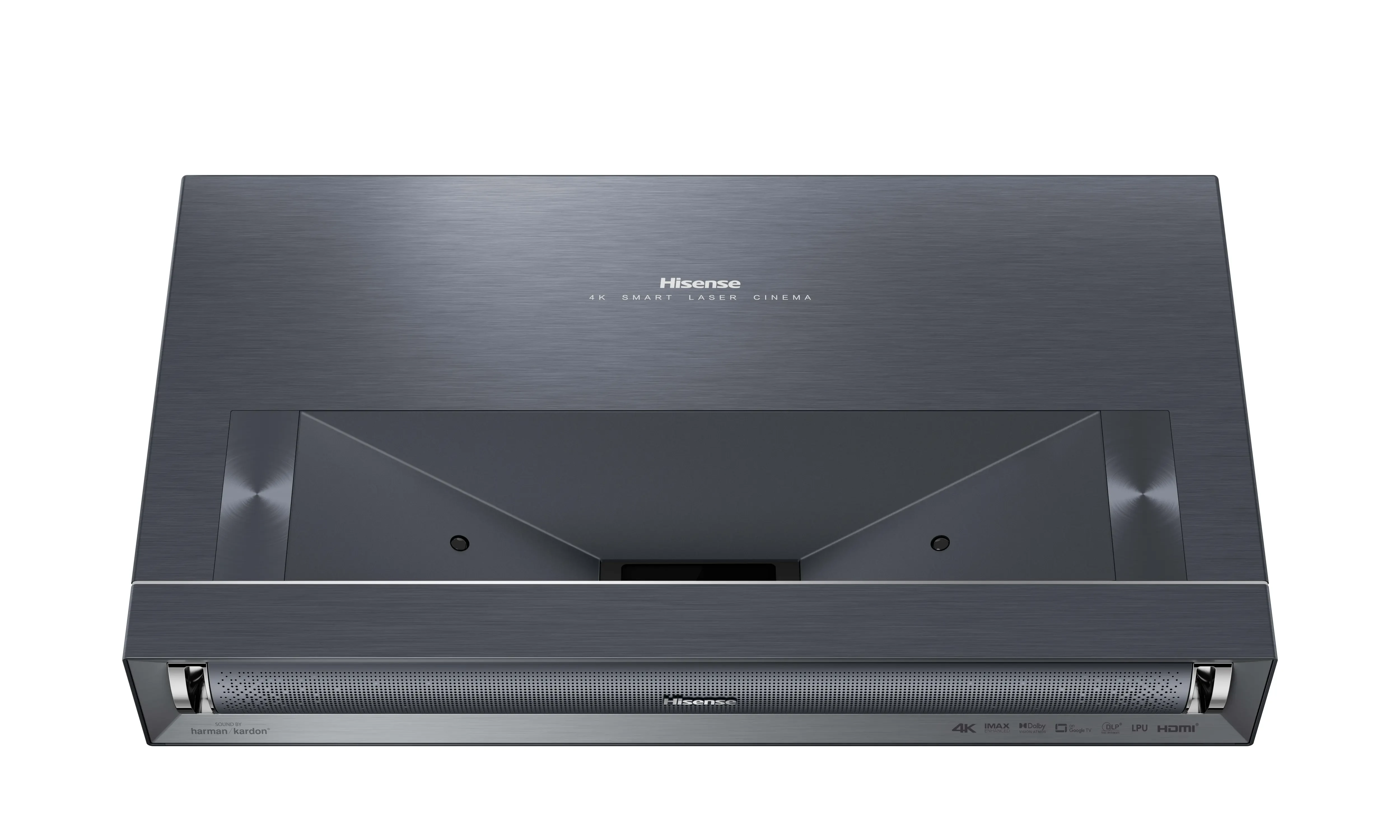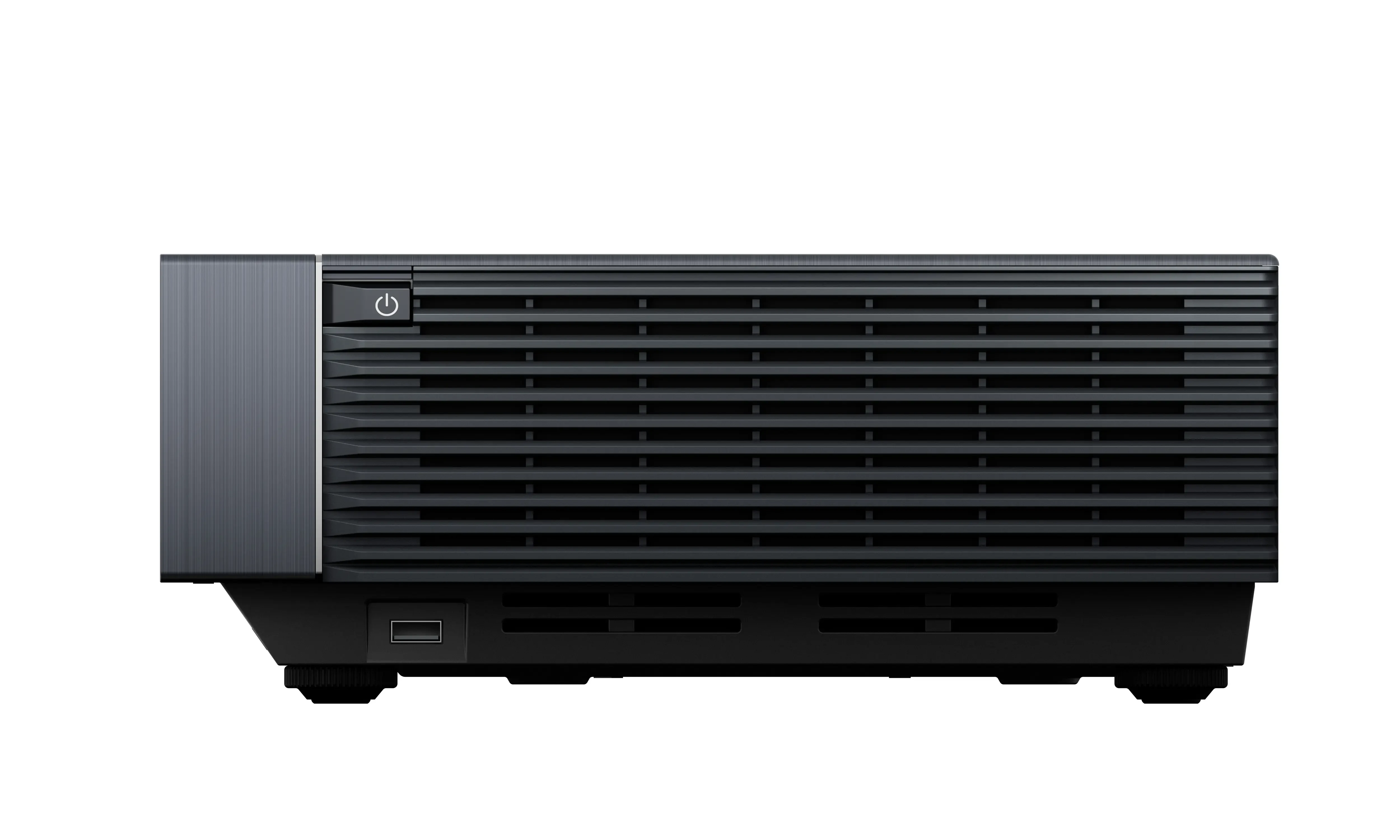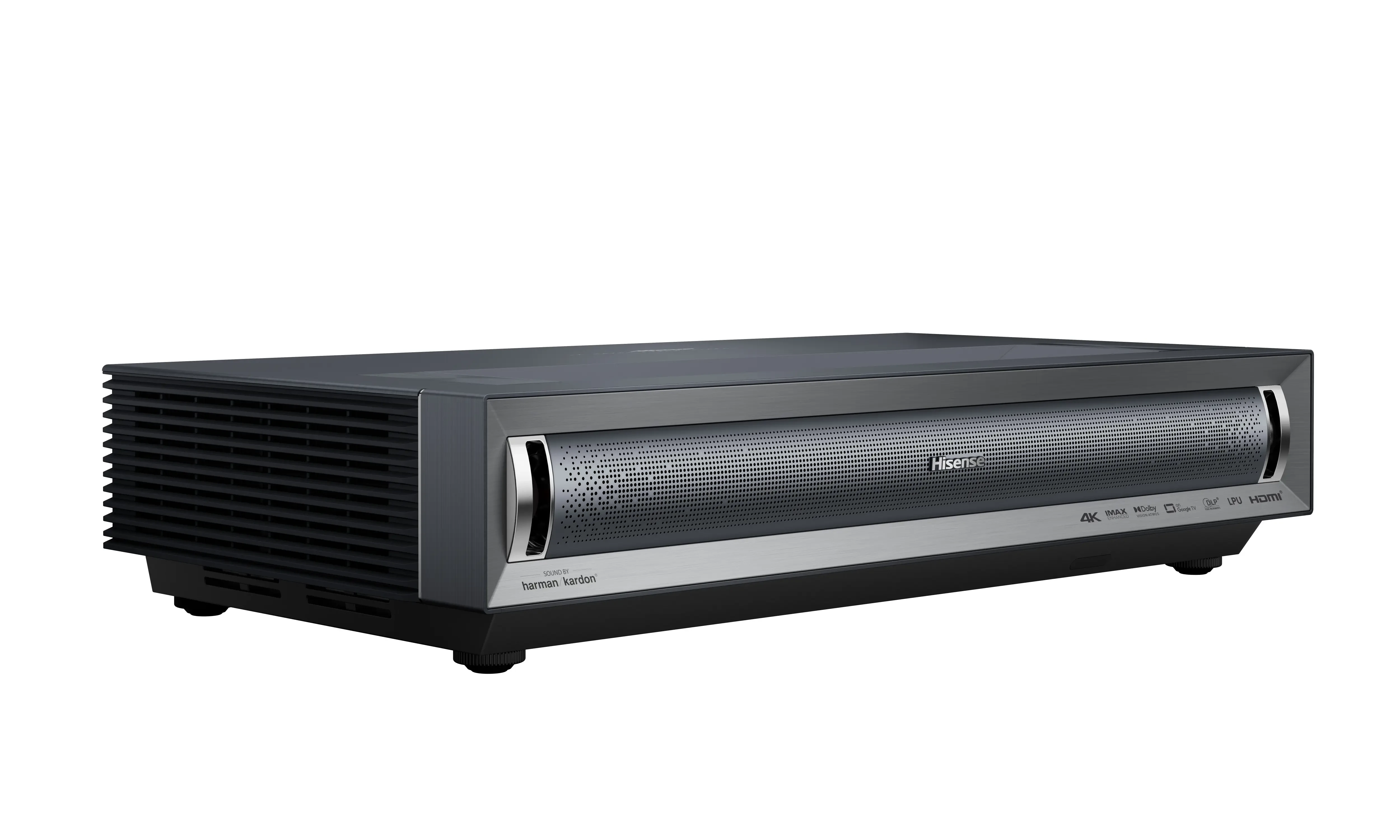| Product Specs | | | Audio | |
| Series | PX3-PRO | | Audio System | Harman Kardon Sound System |
| Type | Triple Colour Laser – UST | | Audio Enhancement | Dolby Atmos Dolby Atmos is an innovative audio technology that provides a more immersive and realistic sound experience for listeners. By incorporating height channels and object-based audio, Dolby Atmos creates a three-dimensional audio space, allowing sound to move around and above the listener, enhancing the overall audio experience. This technology is widely used in cinemas, home theaters, and sound systems, offering an unparalleled level of audio immersion and realism., DTS:X |
| Screen Size | 80″-150″ | | Speaker Power | 2*15W + 2*10W |
| | | | Others | WiSA Ready, User Equalizer |
| Light Source | | | | |
| Lifetime | 25,000 Hours | | Technical | |
| Display Tech | DLP 0.47″ DMD | | User Interface | VIDAA U7.6 |
| Audible Noise | 32dB | | Screen mirroring | Anyview Cast, DLNA |
| | | | Voice Command | VIDAA Voice |
| Lens | | | Installed App | Netflix, YouTube, Prime Video, Airplay |
| Throw Ratio The throw ratio of a projector refers to the ratio of the distance between the projector and the screen to the width of the projected image.
This ratio determines the size of the image based on the projector's distance from the screen, making it a crucial factor in choosing the right projector for a specific space.
To calculate the distance between the projector and its screen using the throw ratio, one can use the following formula: Distance = Throw Ratio x Width of the Image
For instance, if a projector has a throw ratio of 1.5:1 and the desired width of the image is 6 feet, the distance from the projector to the screen would be 1.5 x 6 = 9 feet.
Understanding the throw ratio and its calculation is essential for setting up a projector to achieve the desired image size and optimal viewing experience based on the available space. | 0.22 | | Gaming Features | 2K 240Hz |
| Forus | Powered focus adjustment | | Web Browser | Odin |
| Digital Keystone Correction The keystone adjustment feature on a projector corrects the trapezoidal distortion of the projected image that can occur when the projector is not perpendicular to the screen. This distortion happens when the projector is tilted vertically or horizontally, resulting in a skewed or trapezoid-shaped image rather than a perfect rectangle.
The keystone adjustment allows users to digitally manipulate the projected image's shape, correcting the trapezoidal distortion and ensuring that the image appears rectangular and proportional.
This feature is especially useful when the projector cannot be placed directly in front of the centre of the screen due to space constraints or mounting limitations.
By adjusting the keystone settings, users can align the projected image with the screen, resulting in a more accurate and visually pleasing display. | 9 point | | | |
| | | | Connectivity | |
| Picture | | | WiFi Bands | WIFI 6e |
| Resolution | 4K UHD | | Bluetooth | Yes |
| Colour Depth | 10 bit, 1.07 Colour | | HDMI & USB | HDMI 2.1×2, HDMI 2.0×1, USB 3.0×1, USB 2.0×1 |
| Refresh Rate | 60Hz/ HSR 240 | | HDMI eARC eARC, or enhanced Audio Return Channel, is an HDMI feature that enables high-quality audio signals to be transmitted from a television to an audio system or soundbar using a single HDMI cable. This advanced feature allows for the transmission of uncompressed and higher bandwidth audio signals, supporting formats such as Dolby Atmos and DTS:X for immersive audio experiences. The main difference between ARC (Audio Return Channel) and eARC lies in their capabilities. ARC, which was introduced with HDMI 1.4, allowed for audio to be sent from a television to an audio system over an HDMI cable. However, ARC had limitations in terms of bandwidth and supported audio formats. On the other hand, eARC, introduced with HDMI 2.1, represents a significant advancement over ARC. eARC offers higher bandwidth and supports advanced audio formats, enabling the transmission of high-resolution, uncompressed audio, including object-based audio such as Dolby Atmos, directly from the TV to external audio devices. This results in improved audio fidelity and a more immersive audio experience compared to the limitations of ARC. In summary, the key differences between ARC and eARC are the bandwidth capabilities and support for advanced audio formats. eARC provides a superior audio transmission solution, especially for high-fidelity audio and immersive audio formats, compared to the original ARC standard. | Yes, HDMI 3 |
| Motion Rate | 120 | | Other Port | Ethernet, SPDIF, Earphone Jack, Digital Audio Out |
| Brightness | 3,000 Lumens | | | |
| Wide Colour Gamut Colour gamut refers to the range of colours a projector can display. It is typically measured using the CIE 1931 colour space, which visualizes the range of colours visible to the human eye in a two-dimensional diagram.
This colour space represents a projector's colour gamut, showing the specific colours that the projector can accurately reproduce.
Rec. 709, also known as BT.709, is a standard colour gamut used in high-definition television (HDTV) and Blu-ray discs. It defines the colour space for HDTV with a specific range of colours that can be reproduced.
The Rec. 709 colour space is smaller than the human eye's full range of colours, but it has been widely adopted for HD content production and display.
On the other hand, Rec. 2020, also known as BT.2020, is a standard encompassing a significantly wider colour gamut than Rec. 709. It is designed to represent a much larger range of colours, closer to what the human eye can see.
Rec. 2020 is often associated with ultra-high-definition content and next-generation display technologies, offering a more extensive palette of colours for more vibrant and lifelike imagery.
The measurement of color gamut involves using a spectrophotometer or a colorimeter to analyze the projector's output across various wavelengths of light. This data is then plotted on the CIE 1931 color space diagram to visualize the projector's color gamut. This allows for a quantitative assessment of the projector's color reproduction capabilities according to specific color gamut standards such as Rec. 709 or Rec. 2020. | BT.2020 BT.2020 coverage refers to the colour space coverage defined by the ITU-R BT.2020 standard, encompassing a wider range of colours than the previous standards. It measures a display's ability to reproduce colours within the BT.2020 colour space, which includes more saturated and vibrant colours. A display with high BT.2020 coverage can accurately reproduce a broader range of colours, resulting in vivid and lifelike image quality, particularly for content mastered in the BT.2020 colour space. 110% | | Installation | |
| HDR Compatibility | Dolby Vision Dolby Vision is an advanced HDR (High Dynamic Range) technology developed by Dolby Laboratories. It enhances the viewing experience by providing scene-by-scene or frame-by-frame dynamic metadata to optimize the HDR output. This technology enables compatible displays to deliver brighter highlights, more contrast, and a wider range of colors, resulting in stunning and true-to-life visuals. Dolby Vision aims to provide a more immersive and true-to-life viewing experience by dynamically adjusting the picture settings for each scene, ultimately leading to enhanced image quality and realism., HDR10+, HDR10, HLG | | Product (WxHxD) | 550*296*120mm |
| Engine | LPU Digital Laser Engine | | Accessories | Bluetooth Remote, User Manual, Quick Setup Guide, Power Cable |
| Others | IMAX Enhanced, MEMC MEMC (Motion Estimation, Motion Compensation) is an image processing technology utilised in projectors to enhance the quality of fast-moving images and reduce motion blur during video playback.
The MEMC technology functions by analysing the motion in the original video content and then creating and inserting interim frames between the existing frames. This process effectively increases the frame rate of the video, resulting in smoother transitions and reduced motion blur, especially during fast-paced sequences or high-action content.
By intelligently interpolating frames, MEMC can significantly improve the visual experience when viewing fast-moving content such as sports events or action-packed movies on a projector.
This technology aims to deliver sharper, more fluid motion, enhancing the viewing experience and ensuring that the projected images maintain clarity and smoothness, even during dynamic motion sequences.
In summary, MEMC image processing technology for projectors enhances the visual quality of fast-motion content, contributing to a more immersive and enjoyable viewing experience for audiences., ALLM, 4K AI Upscaler | | | |
